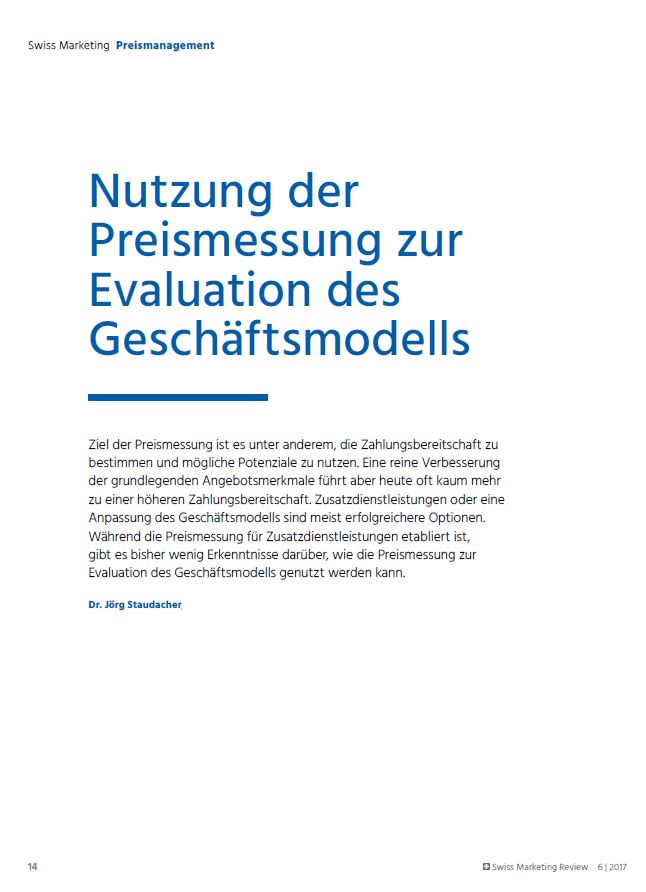Price increase
Price increases are currently being considered or implemented in many industries. This usually happens due to rising commodity prices and/or losses during the pandemic. At first glance, this is not unusual. In the past, however, when the subject of price increases was raised with those responsible, the fears and concerns about carrying them out were usually very great. In the following, we will show why managers find it much easier to raise prices based on external factors than on increased value based on their own performance.
The trigger for this post is that our house bank the ZKB has increased the prices for the account maintenance fee from previously 4 CHF per month to 7 CHF per month. That’s a 75% increase in price. The reason given for this price increase in a simple letter is that the bank has continuously developed its offer in recent years. We have discussed this point internally. We, too, have constantly developed our offering in recent years, investing heavily in digitization and internationalization. Should we also increase our per diem rates by 75%? We can reassure you at this point. We are not introducing expensive chat bots and continue to use digitalization to achieve optimum added value for our customers. The fascinating situation in the banking industry is that most customers will simply accept this price increase. On the one hand, bank offers are characterized by low involvement. The companies simply do not care about a price increase of CHF 36 per year. On the other hand, it is costly to change one’s bank account due to numerous rational binding elements (lock-in). The fact that ZKB is now implementing the price increase will probably also be due to the general mood. Since prices are currently being increased in many industries. What moved us to write this post, besides the fact that we will soon run out of money, is the way the price has been increased.
In a first step we would like to discuss the concept of the Value Stack (attention has nothing to do with electricity). Often, when we address the topic of price management in projects, we experience that those responsible primarily aim to control the optimal sales price for an offer. This is certainly also an important result of a pricing project. For us, however, it is at least as important to understand what influence the individual value components of an offer have on the customer’s price perception? Each offer can be broken down into different building blocks and each customer will assign a different relevance to the different building blocks. Understanding this “value” precisely and, above all, quantifying it, is an important customer insight for companies.
If we look again at the ZKB example. The bank presumably raised prices based on internal cost considerations and a competitive comparison. ZKB’s prices are still relatively attractive even after the price increase. These two forms of price analysis and price determination are very inexpensive and easy to perform. In internal meetings for decision making, the results are also easy to argue. What is sad is that a company like ZKB, which generated a record profit of CHF 941 million in 2021, seems to have little expertise in value and behavioral pricing. Customer-centric pricing offers enormous potential, especially in the event of a price increase. However, building competencies for customer-centric price management is challenging.
Use value and behavioral pricing for a price increase
As a first step, we recommend that companies use choice-based conjoint to understand the customer’s value stack as precisely as possible. The measurement can now be performed very easily with online tools. The challenge is still that companies have to focus on just a few characteristics and features. Here we see that in most companies there is very little knowledge about the elementary dimensions of the value stack from the customer’s point of view and that features are included in the measurement that are hardly relevant from the customer’s point of view.
Let’s take the banking example. Is it really apparent to all customers what investments and improvements ZKB has made in recent years? And the even more exciting question, is each improvement equally valuable to each customer/client? In general, the answer to both questions is rather no. For example, we are annoyed that the credit card is not directly linked to online banking. Other customers will have different criticisms and will value the value proposition of each of the bank’s offering features differently. This would have made it possible to address different segments and their values in communications instead of writing to all customers – we rock, you pay.
Let us assume for the remainder of this discussion that it would have been evident from the available customer data that customers increasingly appreciate the value of ZKB’s numerous changes. Once such robust customer insights regarding the value stack are available, it is important to use the insights of behavioral pricing for implementation. For example, a prior campaign could have comprehensively presented the key value-enhancing activities to customers in order to subsequently gain more acceptance for the price increase. A sentence in a letter that simultaneously introduces a 75% price increase is not ideal. Customers see only the price and negative emotions must arise. A second example is the presentation of the price increase. Basically, price models should show the highest price on the left side and the lowest price on the right side. This recommendation is based on the findings on Loss Aversion. Customers are more inclined to choose the high price in the “high price left/low price right” display when making a purchase decision than when the prices are displayed in reverse order. In case of a price increase, ZKB has put the new (high) price on the left side and the previous (low) price on the right side. This unconsciously leads to the fact that the way the price increase is presented, influences the perception of the customers more than if the presentation had been done the other way around. The fact that the announcement was communicated on a simple gray sheet helps environmental protection, but does not make the value perception any better.
Conclusion on the price increase
For ZKB, this action will be successful. Most customers will accept this price increase. Thus, the bank makes 75% more profit on the business account from July. This raises the critical question, why should such a company build up “expensive” pricing competencies when it can also be done easily? Many other companies can now cite increased raw material prices and/or Corona for the price increase. But let’s put aside the fact that value and behavioral pricing offer enormous profit-boosting potential for companies. Thus, one could also imagine a more complex pricing model for a bank based on price differentiation for different segments. If it is now so easy to conduct a choice-based conjoint, isn’t this topic also about leaving the district league and moving up to the Champions League? Or, to put it another way – doesn’t this scratch a little bit at the honor of companies to have so little competence in the area of customer-oriented price management?
Our offer in the area of pricing consulting
Customers never decide rationally. They are overwhelmed by the many channels and offers. That is why price is becoming increasingly important as a decision-making criterion for customers. Price is thus proven to have the strongest influence on growth and profit. Yet only 2% of companies use customer-oriented pricing. With the help of our pricing consulting, based on value and behavioral pricing approaches and methods, you can shape the purchase decision of your customers in a value-oriented way.
More article on the topic
Conjoint analysis in particular is a powerful way to better understand customers’ willingness to pay and, more importantly, their value stack, and to optimize price increases.






